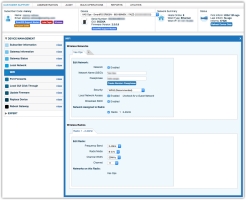Managing WiFi Settings
The Wireless (WiFi) service lets the subscriber connect LAN devices to the CPE device wirelessly. Any WiFi capable LAN device (computers, video streaming devices, web cameras, smart TVs, smart speakers, tablets, etc.) can connect to the subscriber's gateway.
About Wireless Settings
To enable wireless service, specify the following parameters in the Wireless Settings window:
Channel—Is often set to Auto which enable the gateway to select a channel upon powering up or in some cases (depending on make and model), upon reboot. If other WiFi access points nearby are using the same channel, performance may be improved by selecting a specific channel. A gateway device equipped with a 2.4 Ghz WiFi radio vs. a 5Ghz WiFi radio each have their indigenous range of channels displayed for selection from this drop-down list. Variations however might be present.
For example, Device Manager provides support for 5Ghz DFS (Dynamic Frequency Selection) WiFi channels*. They are automatically set by the device and read by Device Manager but one cannot manually select a DFS channel. DFS channels are however visible in Device Manager UI and appear as greyed-out text.
Furthermore, region-specific* channels also impact available options in this drop-down list. When configured, only supported channels for your geographic region are selectable. Un-supported channels for your region are not displayed in the Device Manager UI.
In addition, if the Domains feature is enabled on your Device Manager instance and preferred WiFi channels unique to each Domain have been configured*, those domain-specific channels will be available for selection from the drop-down list while those reserved for other Domains will not be present. Per your specifications, Domain-specific configuration can impact both DFS frequency list and regionally available frequencies.
NOTE: The Domains feature is rarely needed or appropriate to deploy in most provider environments, therefore it is unlikely the Domain-specific channels described above apply.
*A plug-in update to your Device Manager instance may be required. Contact your Sales Engineer for more information on enabling and configuring these features.
Network—Turns the CPE device’s wireless capabilities on or off for this particular network*.
Network Name (SSID)—Displays the CPE device ID; typically a word, code, or short phrase. WiFi capable LAN devices can choose from available SSIDs to connect.
Passphrase—Is a password or phrase used to establish secure communications. You can specify a key, or Device Manager can generate one for you. Subscribers must know the Passphrase to connect LAN devices to the wireless access point. All security types except None require a Passphrase.
Security—Is one of the following:
- None: No password is needed to connect a LAN device to the network. Anyone can connect. None is the least secure setting for a local network.
- WAPWi-Fi Access Protected (WAP): Provides more security than Wireless Equivalent Privacy (WEP). WAP is backward-compatible with WEP.
- WAP2Wi-Fi Access Protected 2 (WAP2): Uses AES encryption and provides the highest level of security available for local networks.
- MixedMixed: Allows devices using WEP, WAP, and WAP2 to connect.
- WEPWEP: Uses stream cipher RC4 encryption for confidentiality protection and CRC-32 for integrity assurance. WEP is the least secure encryption method.
Local Network Access—If configuring a general access network, check this box to enable communication between LAN devices. Leave this box un-checked for a Guest Network that should have internet access only.
Broadcast SSID—Specifies whether the SSID is broadcast to available devices, or whether users must know the SSID to connect.
* Administrators can manage WiFi or subscribers can also perform these tasks from their Control Panel. If the CPE device supports multiple networks, each will have its own tab in the interface where the SSID, Security type, passphrase, etc. can be managed.
Enabling Wireless Service
- In the Wireless Settings window, check the Network check box to enable the wireless service for this network.
- Specify the Network Name (SSID)and any SSID options. The SSID can consist of 1 to 32 characters in length and cannot contain ’ " & < > \
- From the Security menu, choose a security type.
- In the Passphrase field, do one of the following:
- Specify a security key. Depending on the security type selected, passwords must meet the following requirements:
- WEP—5 to 13 characters.
- WPA/WPA2—8 to 30 characters. Cannot contain ’ " & < > \.
- Select the Create Random Passphrase button to generate a key.
- Specify a security key. Depending on the security type selected, passwords must meet the following requirements:
- Select the Save button in the upper-right.
Disabling Wireless Service
- In the Wireless Networks window, select Network checkbox to remove the check mark.
- Select the Save button in the upper-right.
